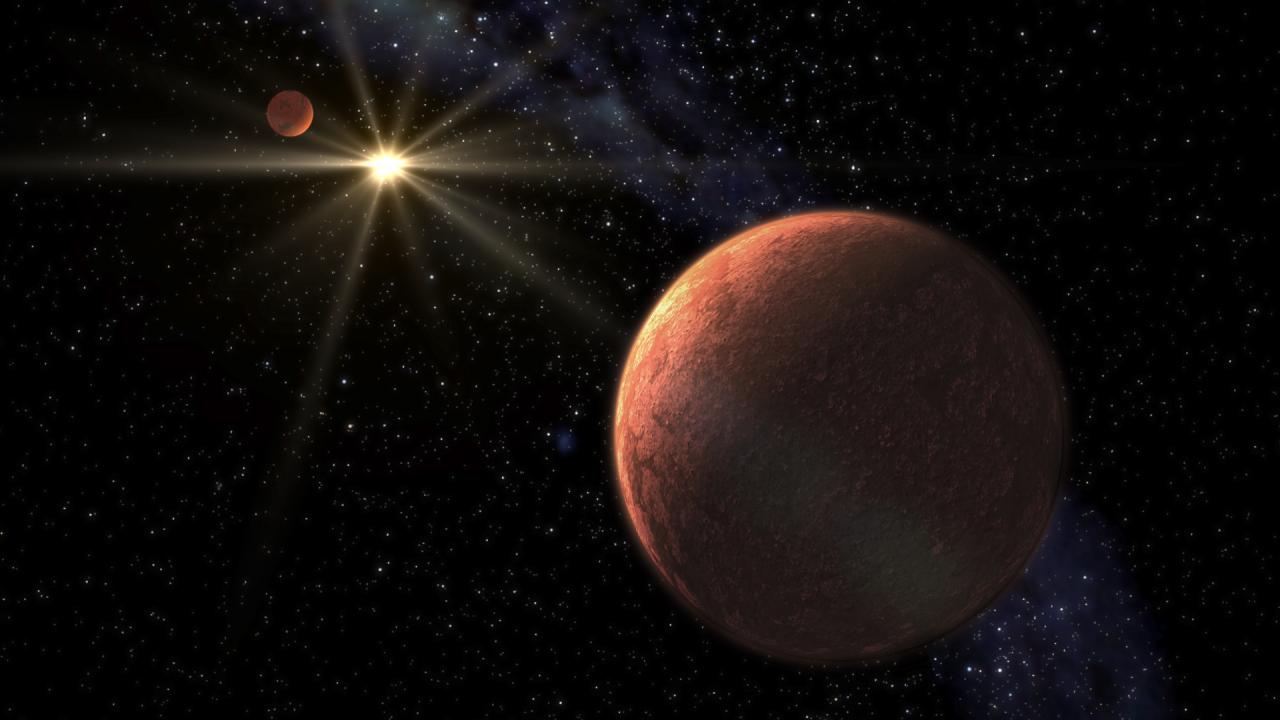Subvenciones relacionadas:
General
Se investigan los procesos que conducen a la formación de estrellas de baja masa, enanas marrones y exoplanetas y caracterizar las propiedades físicas de estos astros en varias etapas evolutivas. Las estrellas de muy baja masa y las enanas marrones son probablemente los objetos más numerosos de nuestra Galaxia, pero no por ello están suficientemente bien establecidas sus propiedades. En particular, los objetos subestelares constituyen uno de los grupos más difíciles de estudiar desde el punto de vista observacional dada su baja luminosidad intrínseca. Se pretende establecer la frecuencia, multiplicidad y distribución espacial de estrellas ultrafrías y objetos subestelares en la vecindad del Sol y en regiones de formación estelar y cúmulos cercanos con el fin de proporcionar información sobre los mecanismos que los originan, caracterizar sus propiedades ópticas e infrarrojas, y establecer relaciones entre sus propiedades espectrales, masas y luminosidades. Se hace especial énfasis en empujar la frontera de detección hacia los objetos de menor masa, bien sea como objetos ligados por atracción gravitatoria a otros, o flotando libremente en el espacio interestelar. Los objetos menos masivos también suelen ser los de menor luminosidad intrínseca y temperaturas superficiales más frías por lo que entrañan notable dificultad de detección por medio de imagen directa. Sin embargo, la detección directa permite una caracterización fotométrica y espectroscópica mucho más completa y una mejor determinación de sus propiedades físicas y químicas. También se pretende investigar la presencia de exoplanetas en estrellas de baja masa empleando técnicas de medida de velocidad radial con muy alta precisión y técnicas de muy alta resolución espacial. Se trabaja en el desarrollo de espectrógrafos ultraestables para grandes telescopios y de sistemas de imagen ultrarrápida. Con los primeros es posible lograr la detección de planetas con masas similares a la de la Tierra en estrellas de tipos G, K y M un objetivo que se persigue es establecer la frecuencia de estos planetas en las estrellas de la vecindad solar y caracterizar las propiedades de los sistemas planetarios a los que pertenecen.
Miembros
Resultados
- La secuencia visible y infrarroja de las enanas de tipo L de 10 Myr de edad en la asociación OB mas cercana al Sol, Upper Scorpius
- El limite estelar/subestelar del cumulo más cercano al Sol, las Hiades
Actividad científica
Publicaciones relacionadas
-
Lithium in the Hyades L5 brown dwarf 2MASS J04183483+2131275Aims: From the luminosity, effective temperature and age of the Hyades brown dwarf 2MASS J04183483+2131275 (2M0418), substellar evolutionary models predict a mass in the range 39-55 Jupiter masses (MJup) which is insufficient to produce any substantial lithium burning except for the very upper range >53 MJup. Our goal is to measure the abundance ofLodieu, N. et al.
Fecha de publicación:
72018 -
Primeval very low-mass stars and brown dwarfs - IV. New L subdwarfs, Gaia astrometry, population properties, and a blue brown dwarf binaryWe present 27 new L subdwarfs and classify five of them as esdL and 22 as sdL. Our L subdwarf candidates were selected with the UKIRT Infrared Deep Sky Survey and Sloan Digital Sky Survey. Spectroscopic follow-up was carried out primarily with the OSIRIS spectrograph on the Gran Telescopio Canarias. Some of these new objects were followed up withZhang, Z. H. et al.
Fecha de publicación:
112018 -
The CARMENES search for exoplanets around M dwarfs. Wing asymmetries of Hα, Na I D, and He I linesStellar activity is ubiquitously encountered in M dwarfs and often characterised by the Hα line. In the most active M dwarfs, Hα is found in emission, sometimes with a complex line profile. Previous studies have reported extended wings and asymmetries in the Hα line during flares. We used a total of 473 high-resolution spectra of 28 active M dwarfsFuhrmeister, B. et al.
Fecha de publicación:
72018 -
Primeval very low-mass stars and brown dwarfs - III. The halo transitional brown dwarfsWe report the discovery of an esdL3 subdwarf, ULAS J020858.62+020657.0, and a usdL4.5 subdwarf, ULAS J230711.01+014447.1. They were identified as L subdwarfs by optical spectra obtained with the Gran Telescopio Canarias, and followed up by optical-to-near-infrared spectroscopy with the Very Large Telescope. We also obtained an optical-to-nearZhang, Z. H. et al.
Fecha de publicación:
92018 -
The CARMENES search for exoplanets around M dwarfs. Photospheric parameters of target stars from high-resolution spectroscopyContext. The new CARMENES instrument comprises two high-resolution and high-stability spectrographs that are used to search for habitable planets around M dwarfs in the visible and near-infrared regime via the Doppler technique. Aims: Characterising our target sample is important for constraining the physical properties of any planetary systemsPassegger, V. M. et al.
Fecha de publicación:
72018 -
The CARMENES search for exoplanets around M dwarfs. Radial-velocity variations of active stars in visual-channel spectraContext. Previous simulations predicted the activity-induced radial-velocity (RV) variations of M dwarfs to range from 1 cm s-1 to 1 km s-1, depending on various stellar and activity parameters. Aims: We investigate the observed relations between RVs, stellar activity, and stellar parameters of M dwarfs by analyzing CARMENES high-resolution visualTal-Or, L. et al.
Fecha de publicación:
62018 -
The CARMENES Search for Exoplanets around M Dwarfs: A Low-mass Planet in the Temperate Zone of the Nearby K2-18K2-18 is a nearby M2.5 dwarf, located at 34 pc and hosting a transiting planet that was first discovered by the K2 mission and later confirmed with Spitzer Space Telescope observations. With a radius of ∼2 R ⊕ and an orbital period of ∼33 days, the planet lies in the temperate zone of its host star and receives stellar irradiation similar to thatSarkis, P. et al.
Fecha de publicación:
62018 -
The CARMENES search for exoplanets around M dwarfs. High-resolution optical and near-infrared spectroscopy of 324 survey starsThe CARMENES radial velocity (RV) survey is observing 324 M dwarfs to search for any orbiting planets. In this paper, we present the survey sample by publishing one CARMENES spectrum for each M dwarf. These spectra cover the wavelength range 520-1710 nm at a resolution of at least R >80 000, and we measure its RV, Hα emission, and projectedReiners, A. et al.
Fecha de publicación:
42018 -
The Lithium Depletion Boundary and the Age of the Hyades ClusterDetermination of the lithium depletion boundary (LDB), i.e., the observational limit below which the cores of very low-mass objects do not reach high enough temperatures for Li destruction, has been used to obtain ages for several open clusters and stellar associations younger than 200 Myr—which until now has been considered the practical upperMartín, E. L. et al.
Fecha de publicación:
32018 -
The CARMENES search for exoplanets around M dwarfs. HD147379 b: A nearby Neptune in the temperate zone of an early-M dwarfWe report on the first star discovered to host a planet detected by radial velocity (RV) observations obtained within the CARMENES survey for exoplanets around M dwarfs. HD 147379 (V = 8.9 mag, M = 0.58 ± 0.08 M⊙), a bright M0.0 V star at a distance of 10.7 pc, is found to undergo periodic RV variations with a semi-amplitude of K = 5.1 ± 0.4 m s-1Reiners, A. et al.
Fecha de publicación:
22018 -
The CARMENES search for exoplanets around M dwarfs . First visual-channel radial-velocity measurements and orbital parameter updates of seven M-dwarf planetary systemsContext. The main goal of the CARMENES survey is to find Earth-mass planets around nearby M-dwarf stars. Seven M dwarfs included in the CARMENES sample had been observed before with HIRES and HARPS and either were reported to have one short period planetary companion (GJ 15 A, GJ 176, GJ 436, GJ 536 and GJ 1148) or are multiple planetary systemsTrifonov, T. et al.
Fecha de publicación:
22018 -
Spectrum radial velocity analyser (SERVAL). High-precision radial velocities and two alternative spectral indicatorsContext. The CARMENES survey is a high-precision radial velocity (RV) programme that aims to detect Earth-like planets orbiting low-mass stars. Aims: We develop least-squares fitting algorithms to derive the RVs and additional spectral diagnostics implemented in the SpEctrum Radial Velocity AnaLyser (SERVAL), a publicly available python codeZechmeister, M. et al.
Fecha de publicación:
12018 -
The optical + infrared L dwarf spectral sequence of young planetary-mass objects in the Upper Scorpius associationWe present the results of photometric and spectroscopic follow-ups of the lowest mass member candidates in the nearest OB association, Upper Scorpius (∼5-10 Myr; 145 ± 17 pc), with the Gran Telescopio de Canarias (GTC) and European Southern Observatory (ESO) Very Large Telescope (VLT). We confirm the membership of the large majority (>80 per cent)Lodieu, N. et al.
Fecha de publicación:
12018 -
Confirming the least massive members of the Pleiades star clusterWe present optical photometry (i and Z band) and low-resolution spectroscopy (640-1015 nm) of very faint candidate members (J = 20.2-21.2 mag) of the Pleiades star cluster (120 Myr). The main goal is to address their cluster membership via photometric, astrometric, and spectroscopic studies, and to determine the properties of the least massiveZapatero Osorio, M. R. et al.
Fecha de publicación:
32018 -
Flare activity and photospheric analysis of Proxima CentauriContext. We present the analysis of emission lines in high-resolution optical spectra of the planet-host star Proxima Centauri (Proxima) classified as a M5.5V. Aims: We carry out a detailed analysis of the observed spectra to get a better understanding of the physical conditions of the atmosphere of this star. Methods: We identify the emissionPavlenko, Y. et al.
Fecha de publicación:
102017 -
Using binary statistics in Taurus-Auriga to distinguish between brown dwarf formation processesContext. One of the key questions of the star formation problem is whether brown dwarfs (BDs) form in the manner of stars directly from the gravitational collapse of a molecular cloud core (star-like) or whether BDs and some very low-mass stars (VLMSs) constitute a separate population that forms alongside stars comparable to the population ofMarks, M. et al.
Fecha de publicación:
82017 -
New ultracool subdwarfs identified in large-scale surveys using Virtual Observatory tools (Corrigendum). I. UKIDSS LAS DR5 vs. SDSS DR7Based on observations made with ESO Telescopes at the La Silla Paranal Observatory under programme ID 084.C-0928A.Based on observations made with the Nordic Optical Telescope, operated on the island of La Palma jointly by Denmark, Finland, Iceland, Norway, and Sweden, in the Spanish Observatorio del Roque de los Muchachos of the Instituto deLodieu, N. et al.
Fecha de publicación:
12017 -
Primeval very low-mass stars and brown dwarfs - II. The most metal-poor substellar objectSDSS J010448.46+153501.8 has previously been classified as an sdM9.5 subdwarf. However, its very blue J - K colour (-0.15 ± 0.17) suggests a much lower metallicity compared to normal sdM9.5 subdwarfs. Here, we re-classify this object as a usdL1.5 subdwarf based on a new optical and near-infrared spectrum obtained with X-shooter on the Very LargeZhang, Z. H. et al.
Fecha de publicación:
62017 -
A new L5 brown dwarf member of the Hyades cluster with chromospheric activityAims: Our aim is to identify brown dwarf members of the nearby Hyades open star cluster to determine the photometric and spectroscopic properties of brown dwarfs at moderately old ages and extend the knowledge of the substellar mass function of the cluster. Methods: We cross-matched the 2MASS and AllWISE public catalogues and measured properPérez-Garrido, A. et al.
Fecha de publicación:
32017 -
Discovery of wide low and very low-mass binary systems using Virtual Observatory toolsThe frequency of multiple systems and their properties are key constraints of stellar formation and evolution. Formation mechanisms of very low-mass (VLM) objects are still under considerable debate, and an accurate assessment of their multiplicity and orbital properties is essential for constraining current theoretical models. Taking advantage ofGálvez-Ortiz, M. C. et al.
Fecha de publicación:
42017



